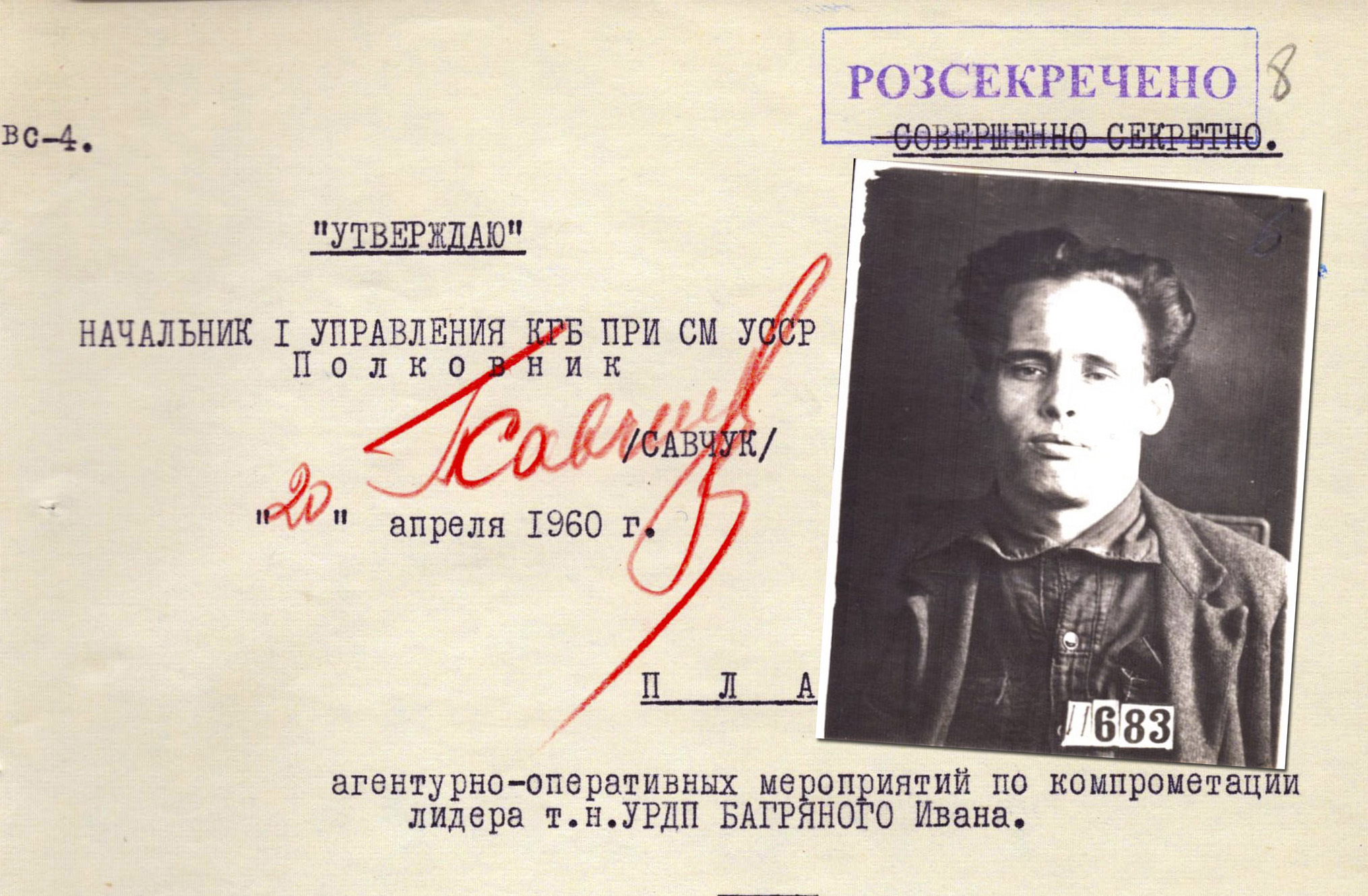Mykola Kapustyanskyi. A Footstep Away from the Planned Assassination by Soviet MGB Agents
2/18/2022
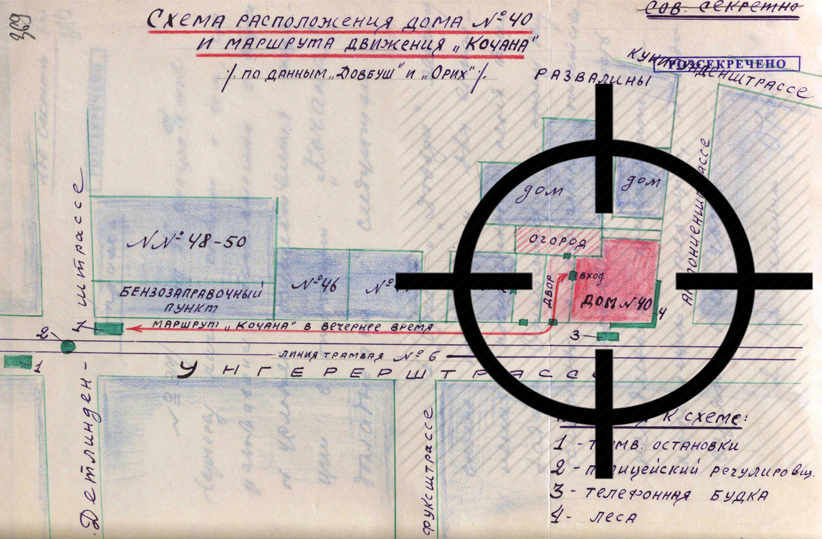
The Foreign Intelligence Service of Ukraine publishes the second part of the materials about the early 1950s’ top-secret operation of the USSR MGB to liquidate one of the leaders of the Ukrainian emigration, a talented Commander of the UPR Army, Minister of Military Affairs in exile, one of the OUN leaders General Mykola Kapustyanskyi. The top secrecy is evidenced by the fact that a number of documents were written only by hand in one copy and kept separately in the appendix to the case, and later - in a special package in the archives of the Soviet Intelligence in Moscow. The schemes, methods and means of assassination tested in this operation were later improved and applied by the USSR KGB during the liquidation of OUN leaders Lev Rebet in 1957 and Stepan Bandera in 1959.
Part 2. To Liquidate
In April 1952, Minister of State Security of the Ukrainian SSR, Lieutenant General Mykola Kovalchuk, received a top secret letter from Moscow, signed by the Deputy Minister of State Security of the USSR, Lieutenant General Serhiy Savchenko. It stated that the leaders of the Ukrainian National Council, the reorganized government of the Ukrainian People's Republic in exile, allegedly began active subversive work against the USSR. In particular, they had intensified contacts with representatives of Germany, Great Britain and the USA in Europe, coordinating joint actions in case of a possible start of a new war and creating mobilization plans for Ukrainian emigration, etc.
This and other documents repeatedly mention the name of General Mykola Kapustyanskyi, who worked on strategic decisions in the military sphere, personally met with the Commander-in-Chief of the anti-Hitler Coalition forces in Europe, American General Dwight Eisenhower, and had great authority in emigration. At the same time, the USSR MGB received information that M. Kapustyanskyi was allegedly the author of a plan to intensify UPA’s actions in Ukraine, and UPR Prime Minister Isaac Mazepa, in his turn, instructed Ataman Taras Bulba-Borovets, organizer of the first insurgent units in Polissya, to develop a similar plan called Polissya Sich UPA. That is, competition for leadership continued between representatives of different currents of emigration continued.
In this situation, according to the foreign agents of the MGB, there were some disagreements between Kapustyanskyi and Bulba-Borovets. The reason was the insurgent Otaman wanted to take the post of Minister of Military Affairs. And the MGB decided to take advantage of this.
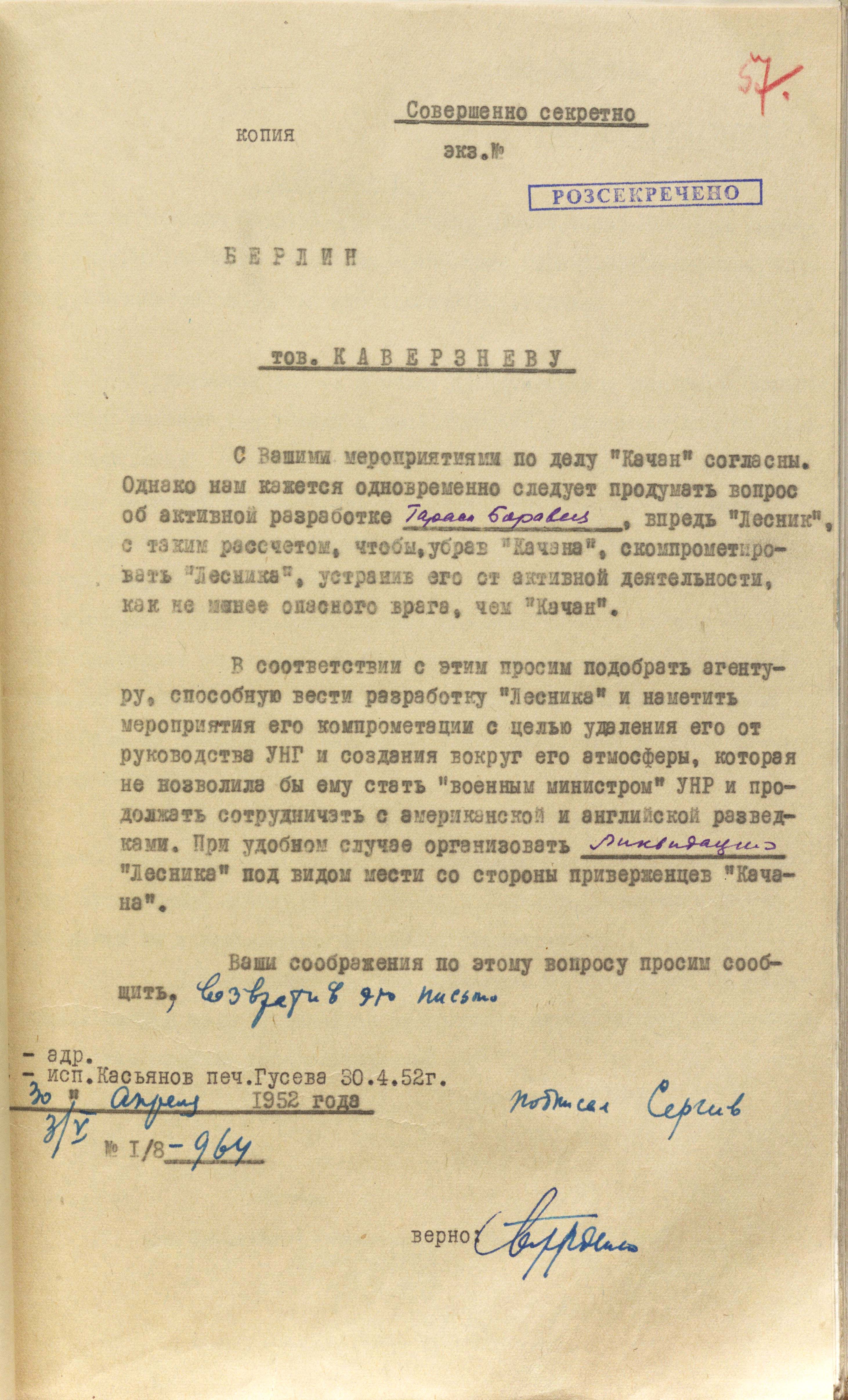
All measures were directly planned and carried out by the Office of the Commissioner of the USSR KGB in the German Democratic Republic. April 12, 1952, its Chief, General Mykhailo Kaverznev, sent a document to the Center to his curator, “Comrade Sergeyev”, justifying the proposal to liquidate M. Kapustyanskyi (listed in the documents as “Kochan”) and the ways to implement this operational plan.
“The first stage, - reads the document - includes only a careful study of the situation around “Kochan” (his way of life, daily routine, environment, protection, location of the house where he lives, and surrounding streets, police regime in the area, etc”. (BSA of the SZR of Ukraine. - F. 1. -Case 10693. - V. 3. - P. 54).
Agent “Zlatovskyi” was to fulfill the task. He had to go to Munich, where M. Kapustyanskyi lived, find him and gather all the necessary information. In particular, it was specified that it was necessary to find out “the routes of his movement to the place of work and walks, whether he visits restaurants and whether he happens to be intoxicated, moves about alone or with security and whether there is security near his house”. Then the agent had to come and report to the KGB office in Karlshorst, a suburb of Berlin.
After the first stage, they had to move on to the second, which provided for the “immediate liquidation of “Kochan”. In a typewritten document, the word “liquidation” was omitted in several places, as was Kapustyanskyi's surname. In this way, the circle of those who could know about the operation was narrowed.
Moscow analyzed this idea and made the following resolution on the document: “Aren't we going to help Borovets, obviously an even more dangerous enemy than “Kochan”, become a Minister? It seems to me that we should work in such a direction that by removing one of them, we could thereby compromise and remove the other from active work” (BSA of the SZR of Ukraine. - F. 1. - Case 10693. - Vol. 3. – P. 56).
In the next document from “Comrade Sergeyev” to General Kaverznev, this thought was developed. Moscow recommended, along with operational measures against Kapustyanskyi, to undertake an active cultivation of Bulba-Borovets, who was given the pseudonym “Lisnyk”. The combination had to be planned in such a way that the suspicion of the liquidation of the Minister of Military Affairs fell on Bulba-Borovets. But that was not all. “Under convenient circumstances”, it was concluded, “to organize the liquidation of “Lisnyk” under the guise of revenge on the part of “Kochan”'s supporters”.
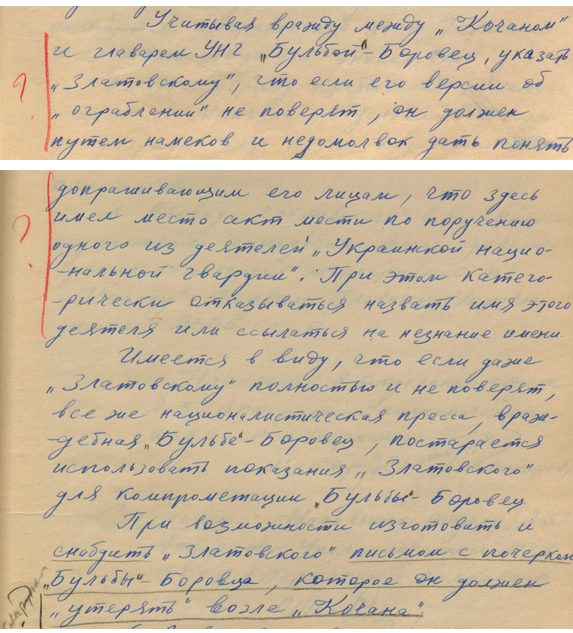
The plan of special measures in the “Kochan” case of July 2, 1952 states in this regard: “If possible, make and provide “Zlatovskyi” with a letter in the handwriting of Bulba-Borovets, which he should “lose” near “Kochan”. Besides, in case of his detention by German police, the agent had to make it clear that he was acting on behalf of one of the members of the Ukrainian National Guard, which was then led by Bulba-Borovets. But he should flatly refuse to name the Otaman. “We mean” - the document said, - “that even if Zlatovskyi is not completely believed, the nationalist press, hostile to Bulba-Borovets, will still try to use Zlatovskyi's words to discredit Bulba-Borovets”. (BSA of the SZR of Ukraine, F. 1. - Case 10693. - V. 3. - P. 369).
Then, at the end of May 1952, agent “Zlatovskyi” was illegally transported to the American zone of occupation of Germany under the guise of a Polish German and with relevant forged documents. He soon reached Munich and found the address 40/3, Ungererstrasse, where Kapustyanskyi was renting a house from German Alfred Mollers. The agent had to stay in Munich for about one month and was given 500 West German marks for expenses.
Already at the final stage of the agent's withdrawal, his task was adjusted. He was not only involved in tracking and gathering information. The written task-legend stated: “Your main task is to track down Kapustyanskyi in the evening, when he returns home alone and in the yard of the house № 40 in Ungererstrasse to liquidate him with the help of the means we will provide you with”.
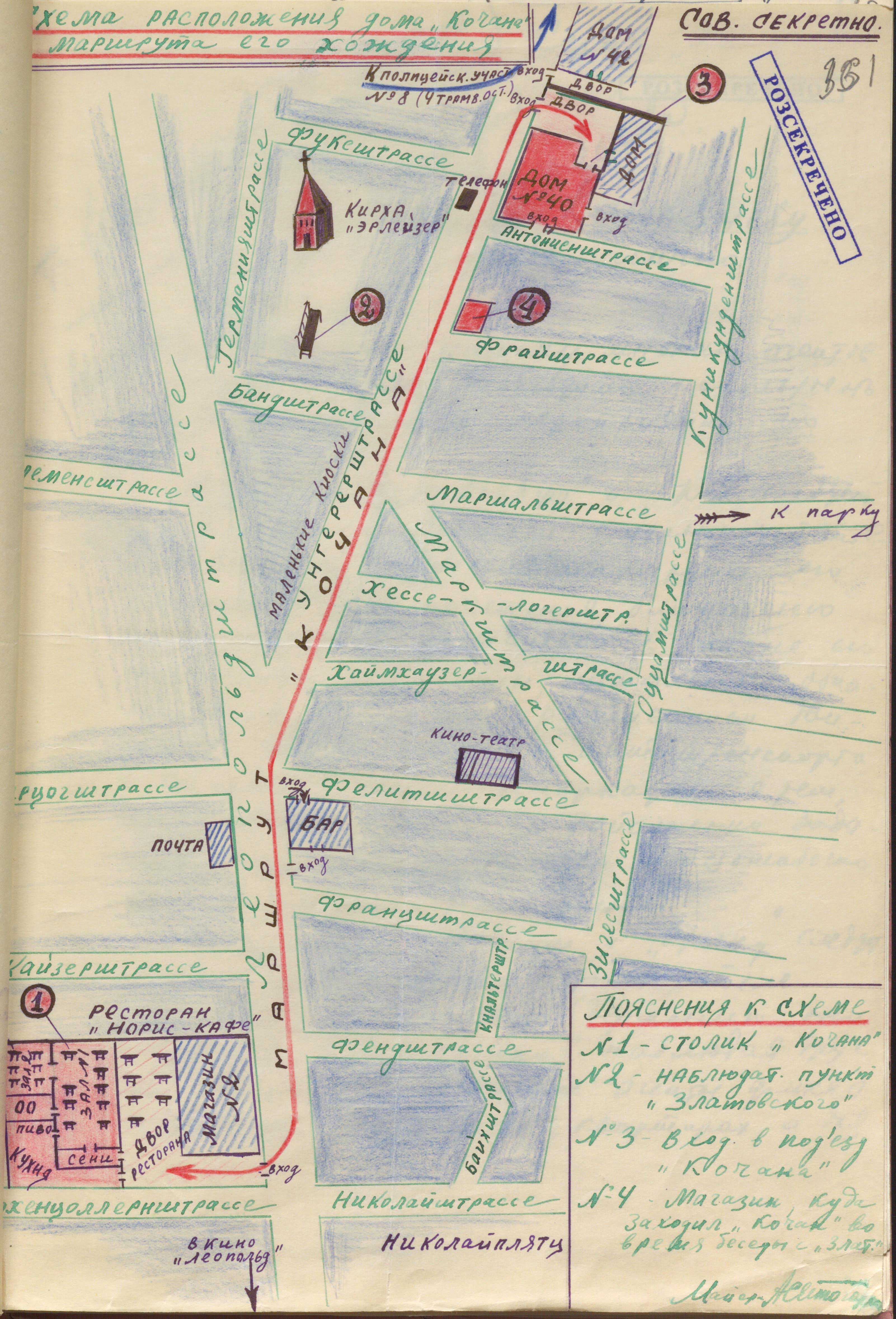
It took “Zlatovskyi” a few days to track down Kapustyanskyi by the distinguishing marks he was given and make sure it was him. The General traditionally dined at the Norris restaurant in Leopoldstrasse. At that time, the agent also went to the restaurant, sat down at the next table and listened to Kapustyanskyi's conversations with his acquaintances. When he heard he was addressed “Mr. General”, he was finally convinced that the man was the one he needed.
According to documents, “Zlatovskyi” somehow found the moment when Kapustyanskyi walked down the street alone, approached and spoke to him in Polish. He said that he had seen him at the Norris restaurant and that he had been pleasantly impressed, so he asked if he could help him find a job. Kapustyanskyi replied that he could not do anything because he had no such connections in Munich. That ended the conversation.
After that, the agent followed the General from afar for several days, but could not ambush him alone in the evening near the house. Then he went back and reported on the progress in the fulfillment of the task.
Taking into account the collected intelligence, the Berlin mission of the USSR KGB decided to send to Munich better trained agents “Dovbush” and “Orikh” for the second stage of the operation, who had already been used to eliminate the UPA underground after World War II. In particular, they were members of the legendary NKVD militias, which included the capture of the Commander of the UPA “West-Carpathians” - “Berkut”, the Chief of the Intelligence of the OUN Provid - “Bohun”, liquidation of a number of OUN activists in Western Ukraine. They had a good command of Polish and German.
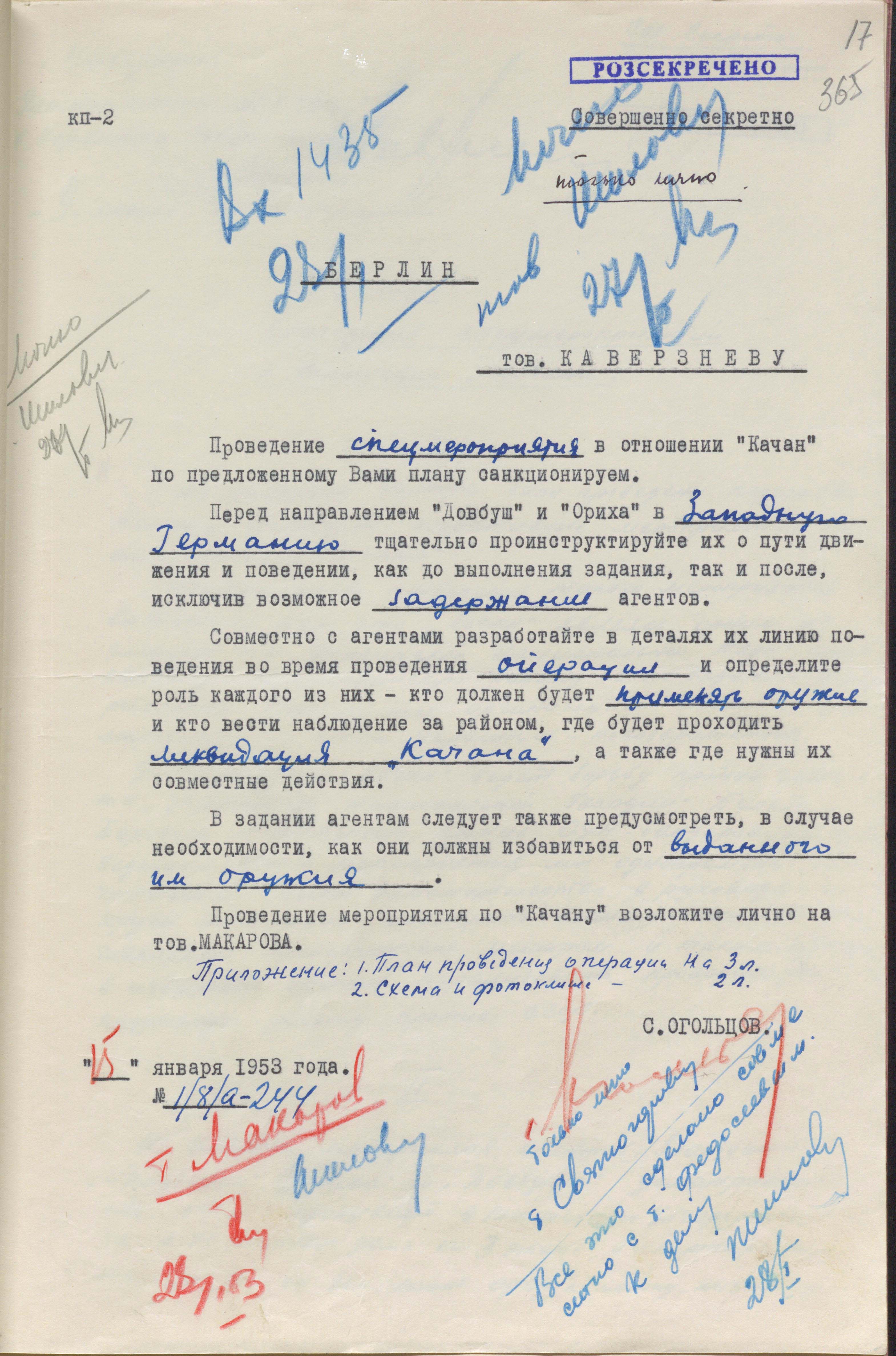
In addition, according to other declassified documents, the agents had already been sent abroad with similar tasks. In particular, in the summer of 1952, they were illegally transported to Germany to kill Petro Kurinnyi, a Ukrainian historian, archaeologist, ethnographer, and museologist. After the Second World War he emigrated and lived in the German city of Hochstadt He was one of the organizers abroad of the Ukrainian Free Academy of Sciences, Professor at the Ukrainian Free University (Munich), Professor of church archeology at the UAOC Theological Academy, conducted various studies on Ukrainian history, was active in the socio-political life of Ukrainian emigration. At first other NKVD agents were sent to him to persuade him to cooperate, but P. Kurinnyi gave them a strong rebuff. After that, Moscow decided to kill the unyielding Professor with the help of agents “Dovbush” and “Orikh”. But the attempt was unsuccessful. No information was found in the declassified archival documents about the reasons for the failure. At the same time, only now has it become known about such an attempt to assassinate a prominent Ukrainian scientist.
To liquidate Kapustyanskyi, the tasks contained clearer and more specific instructions. The liquidation itself was to be carried out by “Orikh”, while “ Dovbush” was to cover and secure his escape. The choice of means to commit murder was discussed separately. The archival documents show that the agents were supposed to be given a special tool developed in the secret laboratories of the NKVD / MGB of the USSR. At first they were curious about it. But soon they realized all the possible risks. To begin with, they themselves were afraid to deal with unusual means of killing, which required certain skills and training. Secondly, they were not sure that it would work one hundred percent.
Archival documents contain information about the agents’ meeting with one of the leaders of the Foreign Intelligence of the USSR MGB, Yevhen Pitovranov. He devoted much of the conversation to the possible use of the so-called “new weapon”. He explained how it was designed, how it could be used and how it worked. During the discussion of the options for the use of that weapon, the agents expressed their views and even suggested, “if possible, to make this “weapon” in the form of a lighter”. They meant that they would try to approach Kapustyanskyi to ask for a cigarette, then get the lighter-special tool and use it to kill him.
In the documents, the word “weapon” is enclosed in quotation marks and written everywhere in the printed text by hand. Neither a detailed description nor the principle of operation is given. Even in internal documents, everything was carefully concealed.

According to the documents, there was a certain discussion about this issue in the governing offices of the USSR MGB both before and after the operation. Some wanted the agents to assassinate Kapustyanskyi with the help of a special means, which was not supposed to leave traces and would hide the cause of death. Others advocated the use of firearms as a proven murder weapon.
One of the reports, dated May 4, 1953, states: “The new weapon that was offered to the agents was allegedly insufficiently tested and practically not used yet” (BSA of the SZR of Ukraine. - F. 1. – Case 10476. - Vol. 1 – P. 256). The paper “On Comrade Sudoplatov’s Report to Comrade Kobulov” of April 6, 1953 contains the following paragraph: “Remarks of Comrade Sudoplatov that the drug “Neptune-28” has not yet passed the relevant tests and therefore its effectiveness cannot be discussed, contradicts the conclusion of the 5th Special Department of the Ministry of Internal Affairs of the USSR about the effectiveness of this drug” (BSA of the SZR of Ukraine. F.1- Case 10693. -V. 3. - P. 364).
So, five years before the assassination of one of the leaders of the OUN, Lev Rebet, with a poisonous substance by aerosol spraying, something similar was planned for Mykola Kapustyanskyi. Eventually, a document was sent from Moscow to Berlin to General Kaverznev, stating: “The use of chemicals or “Surprises” is impossible, as the operation must be carried out on the night street”.
Taking into consideration all the pros and cons, the Center decided to provide agents with a silent mechanism with a processed bullet, which is camouflaged in an object (pen or other). If this is not possible, then allow to use an ordinary pistol with a processed bullet” (BSA of the SZR of Ukraine. - F. 1. - Case 10693. - V. 3. – P. 164). It was implied that the bullet would be treated with a poisonous substance.
In January 1953, the relevant weapon was urgently transported by plane from Moscow to Berlin. After that, “Dovbush” and “Orikh” were smuggled across the border with forged documents and a legend developed accordingly. On the third day after arriving in Munich, they tracked down M. Kapustyanskyi and monitored him for seven days, looking for a convenient opportunity to kill him. By that time, they had already studied the surrounding area, all the streets and alleys, thought over the route and the way to escape after the liquidation, each separately.
On the evening of February 6, 1953, “Dovbush” met with “Orikh”, took a pistol from him, loaded it, and began walking near the house where the General lived. At about 7 p.m., he noticed Kapustyanskyi walking home accompanied by a man. “Dovbush” called him in his mind a “gypsy”. This is what appears in the case file. Despite this, the agent still decided not to wait for another opportunity but do everything that evening.
Later, in his written testimony, “Dovbush”, calling himself a source of information in operative terms, described the situation as follows: “Kapustyansky and the “gypsy” approached the gate of the house № 40. The source, intending to shoot at Kapustyanskyi, approached them at a distance of up to three meters, at this time Kapustyanskyi looked back and looked at the source. At the last second, the source realized that his ill-considered actions could cause significant damage to his state and give away to the enemy a great state secret. With an intensified heartbeat, the source passed Kapustyanskyi at a distance of one meter and, reaching the tram stop, left for the city center”. (BSA of the SZR of Ukraine. - F. 1. – Case 10693. - Vol. 3. – P. 246a).
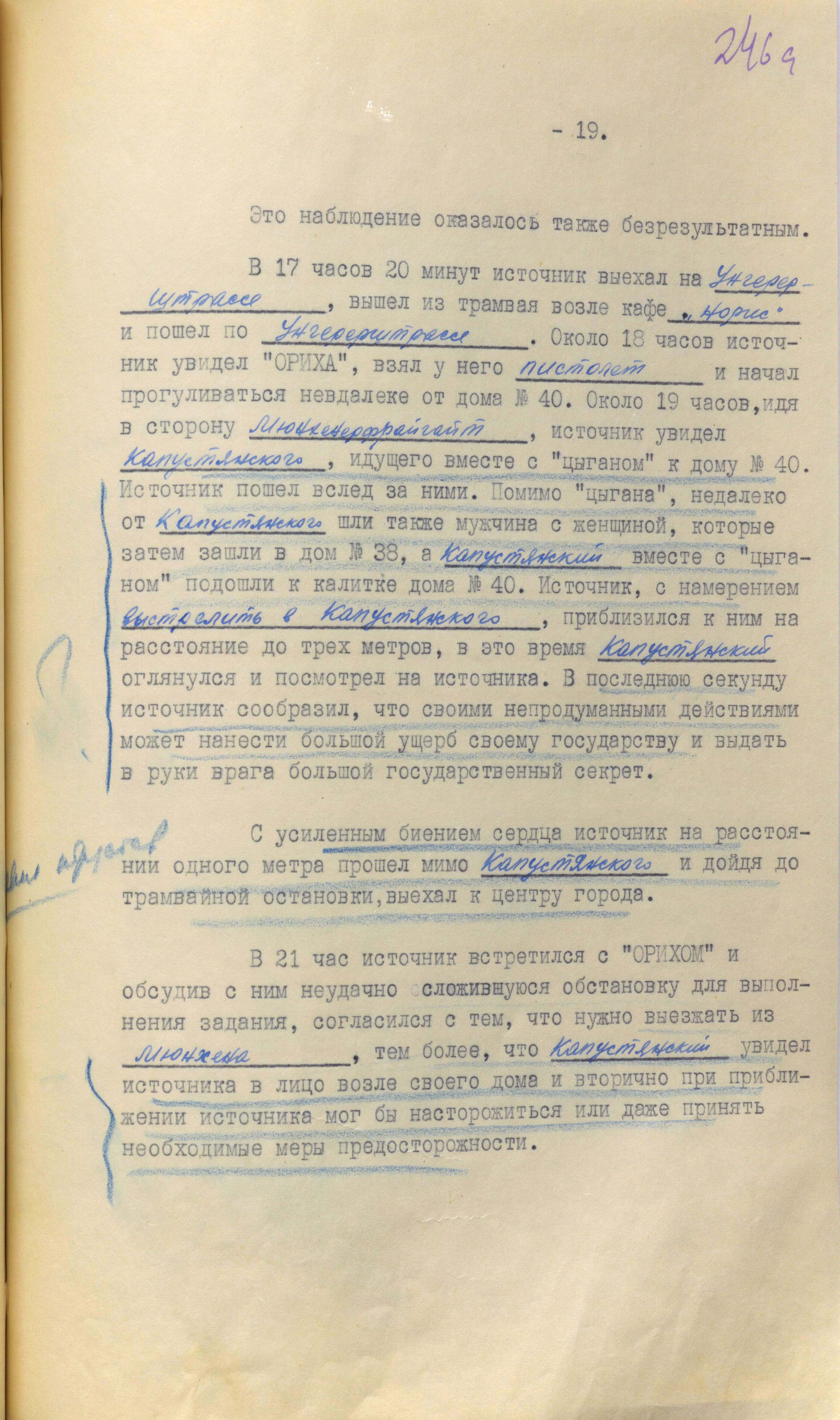
As the agents pointed out in their explanations after their return, the General was constantly among acquaintances. They never managed to ambush him alone. In addition, they allegedly drew the attention of Kapustyanskyi's environment. So they decided not to take any more chances, threw the pistol with ammunition into the river and returned.
The fact that this operation was given special importance is evidenced by the whole subsequent course of events. The Berlin mission of the MGB USSR asked Moscow to “allow “Dovbush” and “Orikh” agents to leave Berlin for a short time to meet with their families in order to maintain their morale”. Such permission was granted. Then the agents, accompanied by operatives, were flown to Moscow, and from there to Kyiv. There they settled in a hotel, to which their wives and children were brought.
Eavesdropping on the conversations between the agents, the printouts of which are stored in the case file, makes it possible to understand why they agreed to the task and how they behaved in the real situation. “We didn't go for the sake of money”, said one of them. - Although money is also important. I could not leave my wife and children without help. We went to do business for the benefit of our people and the Soviet Union”. The other said: “Why didn't you dare… You did such gangster activities before… And because of this moron I have to do harm to my health and children at home”.
He meant that because of Kapustyanskyi, this “enemy of the people”, they were forced to sit in ambush in the cold of winter, track him down, hide so as not to fall into the hands of the police, wander away from families, worry that he could not be assessinated. The agents were very sorry that they did not show determination and did not complete the task. They assured their curators that they would do their best during their next trip to Munich.
Having studied the reports and other operational documents, the leadership of the USSR MGB made certain adjustments to the ideological education of the agents and their combat training. Pavlo Sudoplatov met with them. He wanted to personally assess the psychological state of the agents and their readiness to perform this special task, analyze the situation, understand the reason for its failure, make some suggestions. In particular, he offered to find out more about Kapustyanskyi's mood through the available agents in his environment, to find out whether something had become known about the intentions to assassinate him and whether additional measures were being taken to protect him.
In May 1953, Minister of Internal Affairs of the Ukrainian SSR Pavlo Meshyk sent a letter to Deputy Minister of Internal Affairs of the USSR Bohdan Kobulov, stating that “Dovbush” and “Orikh” after the holiday are now ready to carry out special measures against “Kochan”, but a practical solution to sending them abroad is delayed by the 2nd Main Directorate of the Ministry of Internal Affairs of the USSR” (BSA of the SZR of Ukraine. - F. 1. - Case 10693. - Vol. 3. – P. 316).
To make the second attempt, a Mauser pistol with a device for silent firing was allocated and other preparations began. The plan of measures of the Office of the Commissioner of the Ministry of Internal Affairs of the USSR in the GDR on the Ukrainian line for 1953-1954 states: “To continue the previously started measures to liquidate the “Minister of Military Affairs” of the so-called UN Council Kapustyanskyi”. However, according to the case file, there were some problems with the completion of the operation.
Most likely, after the death of Joseph Stalin in March 1953 and, consequently, the struggle for power in the Kremlin and the radical changes and reorganizations in the state security agencies, a number of cases were put on hold. In particular, in June 1953, leaders of the state security bodies in Moscow and Kyiv were arrested, Lavrentiy Beria, Bohdan Kobulov, Pavlo Meshyk and all. Mykhaylo Kaverznev was transferred from the Berlin office of the Ministry of Internal Affairs of the USSR to a different position, and a year later he was dismissed from the state security bodies “due to incompetence”. Organizational and personnel changes took place at almost all levels, and this, in fact, saved Kapustyanskyi's life.
Archival documents dating from the second half of 1953 show that Kapustyanskyi, at that time, although he left the post of Minister of Military Affairs, did not stop his public and political activities. He was then 72 years old. He often traveled on business from Munich to Paris, was a member of the Central Provid of the OUN (M). His movements continued to be monitored through a foreign agency by the KGB under the Council of Ministers of the USSR.
In 1958, he visited Ukrainians in Canada for the second time. In the Canadian press, he was called the Chief of Staff of the Ukrainian underground liberation movement and Deputy Head of the Ukrainian Nationalists. The archives cite the Times Journal, which reported on one of his speeches. “To win the Cold War”, - Kapustyansky said, - “the Western bloc must change the way it fights the communist threat. It must:
1. Formulate and predict enemy attacks on the psychological, propaganda, ideological and political fronts.
2. Discredit the Kremlin as a threat to the free world and a false peace fighter.
3. Support the desire of enslaved peoples for liberation.
4. Strive for effective political harmony between Western countries.
5. Keep in mind that Ukraine is at the head of the liberation front of the enslaved peoples and therefore in the first place (the Western bloc) must support its struggle "(GDA SZR Ukraine. - F. 1. - Case 10693. - Vol. 2. – P. 209- 210).
In 1959, in accordance with the decision of the KGB Board under the Council of Ministers of the USSR, it was decided that the case materials were of operational interest and needed further development. The case was then transferred to the 1st Directorate of the KGB under the Council of Ministers of the Ukrainian SSR. A separate appendix to the case was a package with the mark “top secret” and the inscription “Not to be opened without the permission of the Chief of the 9th Department of the 1st Main Directorate of the KGB under the Council of Ministers of the USSR or of the Chief of the 1st Directorate of the KGB under the Council of Ministers of the Ukrainian SSR”. A corresponding resolution was issued earlier in this regard. It stated that the documents related to the preparation for special measures against Kapustyanskyi are of special secrecy, so it is not advisable to include them in the current case and they should be kept in a separate package.
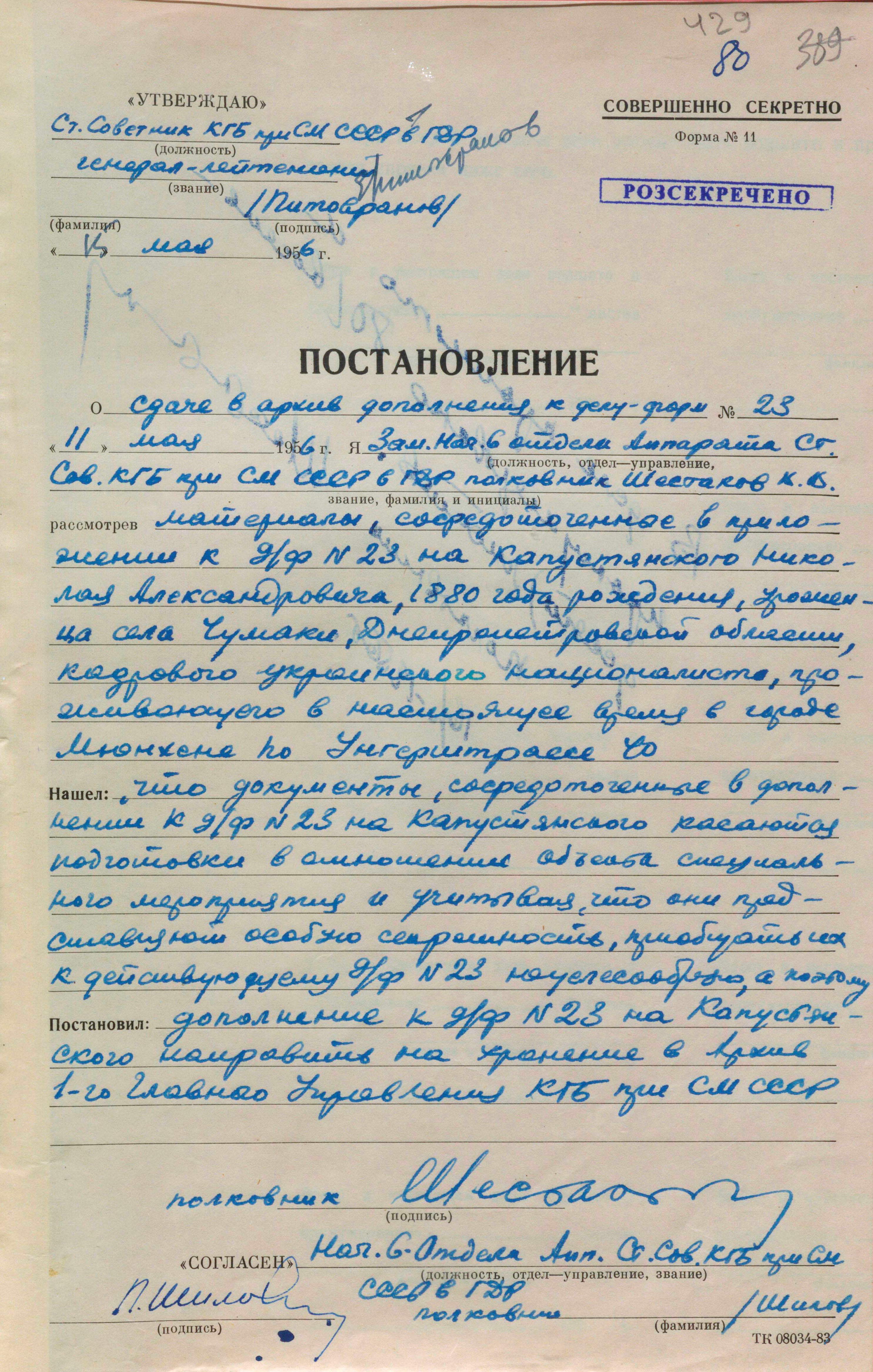
This package, according to the notes on it, was opened two years later. It contained handwritten plans, tasks, briefings, references, explanations of agents about the progress of tasks, materials of operational and technical measures and, most importantly, information about the intention to use special means. They tried to carefully conceal this information even from KGB officers who had nothing to do with all that.
So it is not surprising that such an atmosphere of special secrecy allowed the USSR NKVD / KGB’s special laboratories to work continuously for many years and use terrible weapons with impunity against ideological opponents around the world. According to declassified documents of the Soviet secret services, it was Ukrainian figures who most often fell into those terrible grindstones, and who under no circumstances stopped fighting for a free and independent Ukraine.
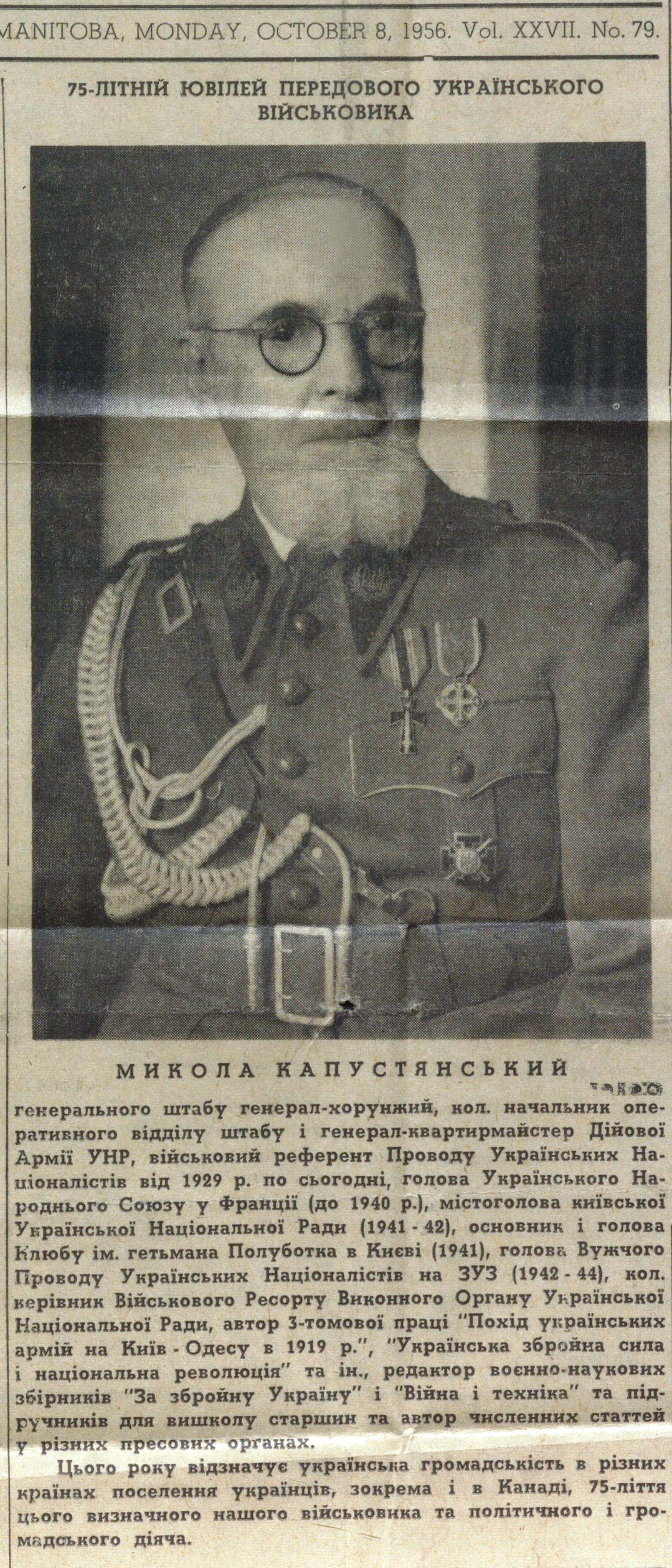
To the last days of his life, Mykola Kapustyanskyi held such positions. He died on February 19, 1969 in Munich, where he was buried. On January 22, 2010, the General's ashes were reburied in Lychakiv Cemetery in Lviv with the appropriate honors given to him by grateful Ukrainians.
According to archival documents, “Orikh” and “Dovbush” agents were kept ready for some time to be taken abroad again. They received no awards, no money, no fame, no honors. On the other hand, the pages of cases are full of considerable sums of money for operational expenses. Then they developed legends of their long absence and brought them back home. “Orikh” soon began abusing alcohol and, in a state of intoxication, boasted that he had once performed important tasks abroad on behalf of the security services. For this, the authorities held a preventive conversation with him. “Dovbush” was preparing to perform another similar task, but soon they decided that his use was inexpedient for a number of reasons. The further fate of these agents is unknown.


